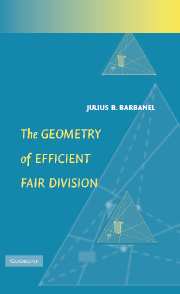Book contents
- Frontmatter
- Contents
- Introduction by Alan D. Taylor
- 1 Notation and Preliminaries
- 2 Geometric Object #1a: The Individual Pieces Set (IPS) for Two Players
- 3 What the IPS Tells Us About Fairness and Efficiency in the Two-Player Context
- 4 The Individual Pieces Set (IPS) and the Full Individual Pieces Set (FIPS) for the General n-Player Context
- 5 What the IPS and the FIPS Tell Us About Fairness and Efficiency in the General n-Player Context
- 6 Characterizing Pareto Optimality: Introduction and Preliminary Ideas
- 7 Characterizing Pareto Optimality I: The IPS and Optimization of Convex Combinations of Measures
- 8 Characterizing Pareto Optimality II: Partition Ratios
- 9 Geometric Object #2: The Radon–Nikodym Set (RNS)
- 10 Characterizing Pareto Optimality III: The RNS, Weller's Construction, and w-Association
- 11 The Shape of the IPS
- 12 The Relationship Between the IPS and the RNS
- 13 Other Issues Involving Weller's Construction, Partition Ratios, and Pareto Optimality
- 14 Strong Pareto Optimality
- 15 Characterizing Pareto Optimality Using Hyperreal Numbers
- 16 Geometric Object #1d: The Multicake Individual Pieces Set (MIPS) Symmetry Restored
- References
- Index
- Symbol and Abbreviations Index
11 - The Shape of the IPS
Published online by Cambridge University Press: 19 August 2009
- Frontmatter
- Contents
- Introduction by Alan D. Taylor
- 1 Notation and Preliminaries
- 2 Geometric Object #1a: The Individual Pieces Set (IPS) for Two Players
- 3 What the IPS Tells Us About Fairness and Efficiency in the Two-Player Context
- 4 The Individual Pieces Set (IPS) and the Full Individual Pieces Set (FIPS) for the General n-Player Context
- 5 What the IPS and the FIPS Tell Us About Fairness and Efficiency in the General n-Player Context
- 6 Characterizing Pareto Optimality: Introduction and Preliminary Ideas
- 7 Characterizing Pareto Optimality I: The IPS and Optimization of Convex Combinations of Measures
- 8 Characterizing Pareto Optimality II: Partition Ratios
- 9 Geometric Object #2: The Radon–Nikodym Set (RNS)
- 10 Characterizing Pareto Optimality III: The RNS, Weller's Construction, and w-Association
- 11 The Shape of the IPS
- 12 The Relationship Between the IPS and the RNS
- 13 Other Issues Involving Weller's Construction, Partition Ratios, and Pareto Optimality
- 14 Strong Pareto Optimality
- 15 Characterizing Pareto Optimality Using Hyperreal Numbers
- 16 Geometric Object #1d: The Multicake Individual Pieces Set (MIPS) Symmetry Restored
- References
- Index
- Symbol and Abbreviations Index
Summary
In this chapter, we investigate the possible shapes of the IPS. In Section 11A, we consider the two-player context, where we shall provide a complete answer. In Section 11B, we consider the n-player context for n > 2, where we are able to provide only a partial answer. For any cake C and corresponding measures m1, m2, …, mn, let IPS(C; m1, m2, …, mn) denote the IPS corresponding to cake C and measures m1, m2, …, mn on C. We make no general assumptions about absolute continuity in this chapter.
The Two-Player Context
In Chapter 2, we considered various properties of the IPS for the case of two players. In particular, we established Theorem 2.4, which told us that the IPS
a. is a subset of [0, 1]2,
b. contains the points (1, 0) and (0, 1),
c. is closed,
d. is convex, and
e. is symmetric about the point (½, ½).
In this section, we show that these five properties completely characterize the possible shapes of the IPS. In other words, for any G ⊆ R2 that satisfies these five conditions, there is a cake C and measures m1 and m2 on C so that G = IPS(C; m1, m2).
Information
- Type
- Chapter
- Information
- The Geometry of Efficient Fair Division , pp. 286 - 297Publisher: Cambridge University PressPrint publication year: 2005
